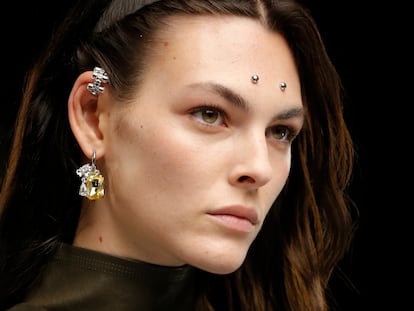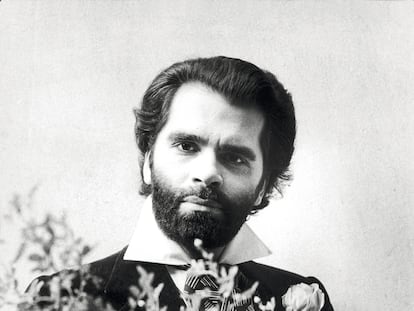What’s behind the latest comeback of Barbour? The politics of a proletariat garment gone high-end
The French fashion house Chloe has signed a collaboration with a brand that was once a staple for fishermen and now represents the British aristocracy

If you were young in the 1990s, you will remember the ubiquitous presence of Barbour waxed jackets among urban trendsetters. Their wearers anointed their garments with a pungent paraffin-based wax, in a practice originally meant to protect the wearers – namely, British landowners – from rainfall and the smell of livestock.
The original Barbours, created by John Barbour in 1894, at the height of the industrial revolution, were created not for ranchers, but for fishermen and sailors. They had fully waterproofed pockets for storing maps or compasses. The models, which were baptized as “Lighthouse,” were not lined with the tartan fabric of the Barbours that are on the market today. Neither did they have a corduroy collar: few other fabrics fare so poorly with the rain.

Barbour jackets came to be associated with British aristocrats, landowners and hunters when the third generation of the family, headed by Margaret Barbour, managed to make their clothes popular among hunters, earning her a Royal Warrant granted by the Duke of Edinburgh in 1972. Margaret understood that the brand ought to capitalize on its connection with the world of old money. Starting in 1980, the company did a complete U-turn in its marketing strategy. Its catalogs now showed aristocratic-looking couples walking their pedigreed dogs through the countryside.
During that period, the company launched its three most iconic models, also the most versatile to wear in the city: Bedale, Beaufort and Border, which incorporated corduroy collars and checked lining. This change came just as Queen Elizabeth II and the Prince of Wales awarded Barbour the Royal Warrants, which represent the highest honor in the world of British luxury. In the following decade, the fever for these jackets spread throughout Europe. Barbour stores continue to offer the waxing service, which helps to keep the fabric in perfect condition and perpetuate the jacket’s legendary smell.
Since then, Barbour has continued to be a classic brand with a fine reputation. Its success among young people faded, however, until the 2000s when Arctic Monkeys singer Alex Turner began wearing the jackets at his concerts. He promoted the revival of the very British style that mixes the clochard aesthetic of the French New Wave and existentialism with rural mysticism (think Paul McCartney and his wife Linda in their farm years in the depths of Scotland). Turner’s ex-partner, the influencer and model Alexa Chung, was the ideologue of the umpteenth reinterpretation of Swinging London. For seven years, she has had her own Barbour collection, which includes a version of fishermen’s capes, harking back to the garment’s origins, and honors Queen Elizabeth, a devotee of the brand, with a best-selling raincoat.

For several seasons, Barbour has once again been on the wish list of fashionistas. The luxury fashion websites Net-a-Porter and Yoox include it among their list of brands. The brand’s popularity comes at a time when Great Britain is seeing a rise of nationalism and nostalgia for a “purely British” lifestyle – an ideal embodied in the Netflix series The Crown (it does not exist in real life).
This year, Barbour’s umpteenth resurrection comes thanks to the French firm Chloe, which was founded in the 1950s by Gaby Aghion, a Parisian woman of Egyptian origin. When it was founded, the brand was linked with the educated women of the upper middle class. That legacy was later picked up by the legendary Phoebe Philo, who introduced into the female imagination the idea that a heavy camel coat could be worn with sneakers and that a good cashmere sweater is as luxurious as a good piece of jewelry. It’s a vision that compliments that of Barbour, which advertises that the back pocket of the Beaufort model is used to store game, while the side pocket of the Bedale model can fit a bottle of champagne.
The collaboration takes place with the family’s fourth generation at the helm, represented again by a woman, Helen Barbour. In the 1990s, she introduced exclusive tartan patterns for the inside of the jackets, and in 2014, she began to design clothes for dogs, since she wanted clothes for her own pets. She has also sold the idea that a Barbour jacket is a “legacy” item i.e. a garment to be handed down to the next generation. As for whether Barbour is a conservative brand, that all depends on when one starts telling its story.
Tu suscripción se está usando en otro dispositivo
¿Quieres añadir otro usuario a tu suscripción?
Si continúas leyendo en este dispositivo, no se podrá leer en el otro.
FlechaTu suscripción se está usando en otro dispositivo y solo puedes acceder a EL PAÍS desde un dispositivo a la vez.
Si quieres compartir tu cuenta, cambia tu suscripción a la modalidad Premium, así podrás añadir otro usuario. Cada uno accederá con su propia cuenta de email, lo que os permitirá personalizar vuestra experiencia en EL PAÍS.
¿Tienes una suscripción de empresa? Accede aquí para contratar más cuentas.
En el caso de no saber quién está usando tu cuenta, te recomendamos cambiar tu contraseña aquí.
Si decides continuar compartiendo tu cuenta, este mensaje se mostrará en tu dispositivo y en el de la otra persona que está usando tu cuenta de forma indefinida, afectando a tu experiencia de lectura. Puedes consultar aquí los términos y condiciones de la suscripción digital.
More information
Últimas noticias
Welcome to the post-religion era: The idea of Christianity as the absolute truth has become obsolete
‘I thought you would like it’: The risky sexual practice popularized by TV shows and TikTok
The digitalization of tourism: ‘They promise experiences and gave us the worst possible one’
Mexican peso defies uncertainty with forecasts of a new period of stability in 2026
Most viewed
- Sinaloa Cartel war is taking its toll on Los Chapitos
- Reinhard Genzel, Nobel laureate in physics: ‘One-minute videos will never give you the truth’
- Oona Chaplin: ‘I told James Cameron that I was living in a treehouse and starting a permaculture project with a friend’
- Why the price of coffee has skyrocketed: from Brazilian plantations to specialty coffee houses
- Silver prices are going crazy: This is what’s fueling the rally











































